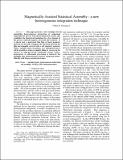| dc.contributor.author | Fonstad, Clifton G. Jr. | |
| dc.date.accessioned | 2003-12-20T19:43:44Z | |
| dc.date.available | 2003-12-20T19:43:44Z | |
| dc.date.issued | 2002-01 | |
| dc.identifier.uri | http://hdl.handle.net/1721.1/3978 | |
| dc.description.abstract | This paper presents a new technique for the monolithic heterogeneous integration of compound semiconductor devices with silicon integrated circuits, and establishes the theoretical foundation for a key element of the process, tailored magnetic attraction and retention. It is shown how a patterned thin film of hard magnetic material can be used to engineer the attraction between the film and nanopills covered with a soft magnetic material. With a suitable choice of pattern, it is anticipated that it will be possible to achieve complete filling of recesses in the surface of fully-processed integrated circuit wafers, preparatory to subsequent processing to fabricate the nanopills into heterostructure devices integrated monolithically with the pre-existing electronics. | en |
| dc.description.sponsorship | Singapore-MIT Alliance (SMA) | en |
| dc.format.extent | 96834 bytes | |
| dc.format.mimetype | application/pdf | |
| dc.language.iso | en_US | |
| dc.relation.ispartofseries | Advanced Materials for Micro- and Nano-Systems (AMMNS); | |
| dc.subject | optoelectronics | en |
| dc.subject | heterogeneous integration | en |
| dc.subject | self assembly | en |
| dc.subject | VCSELs | en |
| dc.subject | III-V heterostructures | en |
| dc.title | Magnetically-Assisted Statistical Assembly - a new heterogeneous integration technique | en |
| dc.type | Article | en |

